A Study of Water-Based Nanolubricants Using Hexagonal Boron Nitride (hBN)-Based Nanocomposites as Lubricant Additives
Abstract
:1. Introduction
2. Materials and Methods
2.1. Materials
2.2. Tribological Tests
2.3. Appraisal Techniques
3. Results
3.1. Nanoparticles Characterisation
3.2. Dispersion Stability
3.3. COF
3.4. Wear of Disk and Ball
4. Discussion
5. Conclusions
- The water-based nanolubricants showed satisfactory dispersion stability for a duration of up to 7 days without visible sedimentation.
- hBN/TiO2 nanolubricants showed excellent synergy in reducing both friction and wear produced by distilled water. Considering the extent of friction reduction, the order was as follows: Lubricant C (70%) > Lubricant B (67.18%) > Lubricant D (66.91%) > Lubricant E (66.59%) > Lubricant A (65.28%).
- The anti-wear performance of hBN/TiO2 nanolubricants, in terms of reduced disk wear from that of water lubrication, was as follows: Lubricant C (60.40%) > Lubricant D (50.94%) > Lubricant B (41.15%) > Lubricant E (34.25%) > Lubricant A (29.82%); and the following was based on reduced ball wear: Lubricant C (79.57%) > Lubricant D (75.36%) > Lubricant B (72.97%) > Lubricant E (65.63%) > Lubricant A (63.27%).
- Among all the water-based lubricants, Lubricant C, containing 0.5 wt% of hBNNSs and 0.5 wt% TiO2 NPs, showed the best lubrication performance through reducing the COF, wear of ball and disk by 70%, 79.57%, and 60.40%, respectively, compared to those produced by distilled water.
- The lubrication mechanisms of hBN/TiO2 water-based lubricants were primarily governed by the rolling and mending effects, along with the protective film formation and synergistic effects of the hBNNSs and TiO2 NPs.
Author Contributions
Funding
Data Availability Statement
Acknowledgments
Conflicts of Interest
References
- Singh, A.; Chauhan, P.; Mamatha, T.G. A review on tribological performance of lubricants with nanoparticles additives. Mater. Today Proc. 2020, 25, 586–591. [Google Scholar] [CrossRef]
- Shahnazar, S.; Bagheri, S.; Abd Hamid, S.B. Enhancing lubricant properties by nanoparticle additives. Int. J. Hydrogen Energy 2016, 41, 3153–3170. [Google Scholar] [CrossRef]
- Aizarani, J. Global Lubricant Demand 2000–2028; Statista Research Department: Hamburg, German, 2023. [Google Scholar]
- Heikkilä, P. Bio-Based Carbon Materials Road-Map; VTT Technical Research Centre of Finland: Espoo, Finland, 2016; Volume VTT-R-00181-16, p. 51. [Google Scholar]
- Zhang, W.; Demydov, D.; Jahan, M.P.; Mistry, K.; Erdemir, A.; Malshe, A.P. Fundamental understanding of the tribological and thermal behavior of Ag–MoS2 nanoparticle-based multi-component lubricating system. Wear 2012, 288, 9–16. [Google Scholar] [CrossRef]
- Xu, W.; Li, C.; Zhang, Y.; Ali, H.M.; Sharma, S.; Li, R.; Yang, M.; Gao, T.; Liu, M.; Wang, X.; et al. Electrostatic atomization minimum quantity lubrication machining: From mechanism to application. Int. J. Extrem. Manuf. 2022, 4, 042003. [Google Scholar] [CrossRef]
- Contributors, W. Nanofluid. The Free Encyclopedia: Wikipedia. 2023. Available online: https://en.wikipedia.org/wiki/Nanofluid (accessed on 15 November 2023).
- Deshmukh, M.R.; Patil, D.R.J. Review paper on performance of hydrodynamic journal bearing with nano particles in lubricating oil. Int. J. Sci. Res. Dev. 2016, 3, 4. [Google Scholar]
- Singh, A.A.S.W. A review paper on performance analysis of hydrodynamic journal bearing with various types of lubricant for pressure distribution and cavitation. Int. J. Adv. Eng. Res. 2017, 4, 347–354. [Google Scholar]
- Mang, T.; Lingg, G. Base Oils. In Lubricants and Lubrication; WILEY-VCH Verlag GmbH & Co. KGaA: Weinheim, Germany, 2017; pp. 51–82. [Google Scholar]
- Huang, H.D.; Tu, J.P.; Gan, L.P.; Li, C.Z. An investigation on tribological properties of graphite nanosheets as oil additive. Wear 2006, 261, 140–144. [Google Scholar] [CrossRef]
- Lo, S.-W.; Yang, T.-C.; Cian, Y.-A.; Huang, K.-C. A Model for Lubrication by Oil-in-Water Emulsions. J. Tribol. 2009, 132, 011801. [Google Scholar] [CrossRef]
- Gulzar, M.; Masjuki, H.H.; Kalam, M.A.; Varman, M.; Zulkifli, N.W.M.; Mufti, R.A.; Zahid, R. Tribological performance of nanoparticles as lubricating oil additives. J. Nanopart. Res. 2016, 18, 223. [Google Scholar] [CrossRef]
- Wu, H.; Zhao, J.; Cheng, X.; Xia, W.; He, A.; Yun, J.-H.; Huang, S.; Wang, L.; Huang, H.; Jiao, S.; et al. Friction and wear characteristics of TiO2 nano-additive water-based lubricant on ferritic stainless steel. Tribol. Int. 2018, 117, 24–38. [Google Scholar] [CrossRef]
- Morshed, A.; Wu, H.; Jiang, Z. A Comprehensive Review of Water-Based Nanolubricants. Lubricants 2021, 9, 89. [Google Scholar] [CrossRef]
- Wu, H.; Zhao, J.; Xia, W.; Cheng, X.; He, A.; Yun, J.H.; Wang, L.; Huang, H.; Jiao, S.; Huang, L.; et al. Analysis of TiO2 nano-additive water-based lubricants in hot rolling of microalloyed steel. J. Manuf. Process. 2017, 27, 26–36. [Google Scholar] [CrossRef]
- Donald, A.; Lelonis, J.W.T.; Cynthia, M.A. Boron Nitride Powder—A High-Performance Alternative for Solid Lubrication. GE Adv. Ceram. 2003, 4. [Google Scholar]
- Kimura, Y.; Wakabayashi, T.; Okada, K.; Wada, T.; Nishikawa, H. Boron nitride as a lubricant additive. Wear 1999, 232, 199–206. [Google Scholar] [CrossRef]
- Engler, M.; Lesniak, C.P.; Damasch, R.; Ruisinger, B.; Eichler, J. Hexagonal Boron Nitride (hBN): Applications from Metallurgy to Cosmetics. Cfi-Ceram. Forum Int. 2007, 84, E49–E53. [Google Scholar]
- Lipp, A.; Schwetz, K.A.; Hunold, K. Hexagonal boron nitride: Fabrication, properties and applications. J. Eur. Ceram. Soc. 1989, 5, 3–9. [Google Scholar] [CrossRef]
- Paine, R.T.; Narula, C.K. Synthetic routes to boron nitride. Chem. Rev. 1990, 90, 73–91. [Google Scholar] [CrossRef]
- Zeng, H.; Zhi, C.; Zhang, Z.; Wei, X.; Wang, X.; Guo, W.; Bando, Y.; Golberg, D. “White Graphenes”: Boron Nitride Nanoribbons via Boron Nitride Nanotube Unwrapping. Nano Lett. 2010, 10, 5049–5055. [Google Scholar] [CrossRef]
- Haubner, R.; Wilhelm, M.; Weissenbacher, R.; Lux, B. Boron Nitrides—Properties, Synthesis and Applications. In High Performance Non-Oxide Ceramics II; Jansen, M., Ed.; Springer: Berlin/Heidelberg, Germany, 2002; pp. 1–45. [Google Scholar]
- Naclerio, A.E.; Kidambi, P.R. A Review of Scalable Hexagonal Boron Nitride (h-BN) Synthesis for Present and Future Applications. Adv. Mater. 2023, 35, 2207374. [Google Scholar] [CrossRef]
- Gachechiladze, A.; Tsagareishvili, O.; Margiev, B.; Rukhadze, L.; Darchiashvili, M.; Chkhartishvili, L. Nanopowdered h-BN as a Wear-Reducing Eco-Friendly Material; Springer: Berlin/Heidelberg, Germany, 2019; pp. 2389–2408. [Google Scholar]
- Bai, Y.; Wang, L.; Ge, C.; Liu, R.; Guan, H.; Zhang, X. Atomically thin hydroxylation boron nitride nanosheets for excellent water-based lubricant additives. J. Am. Ceram. Soc. 2020, 103, 6951–6960. [Google Scholar] [CrossRef]
- Şirin, Ş.; Kıvak, T. Effects of hybrid nanofluids on machining performance in MQL-milling of Inconel X-750 superalloy. J. Manuf. Process. 2021, 70, 163–176. [Google Scholar] [CrossRef]
- Vicki Wanatasanappan, V.; Kumar Kanti, P.; Sharma, P.; Husna, N.; Abdullah, M.Z. Viscosity and rheological behavior of Al2O3-Fe2O3/water-EG based hybrid nanofluid: A new correlation based on mixture ratio. J. Mol. Liq. 2023, 375, 121365. [Google Scholar] [CrossRef]
- Kumar Kanti, P.; Sharma, P.; Sharma, K.V.; Maiya, M.P. The effect of pH on stability and thermal performance of graphene oxide and copper oxide hybrid nanofluids for heat transfer applications: Application of novel machine learning technique. J. Energy Chem. 2023, 82, 359–374. [Google Scholar] [CrossRef]
- Huang, Z.; Zhao, W. Coupling hybrid of HBN nanosheets and TiO2 to enhance the mechanical and tribological properties of composite coatings. Prog. Org. Coat. 2020, 148, 105881. [Google Scholar] [CrossRef]
- Harichandran, R.; Selvakumar, N. Microstructure and mechanical characterization of (B4C+ h-BN)/Al hybrid nanocomposites processed by ultrasound assisted casting. Int. J. Mech. Sci. 2018, 144, 814–826. [Google Scholar] [CrossRef]
- Lee, H.H.; Kim, S.H.; Joshi, B.; Lee, S.W. A Study on Mechanical and Tribological Properties of Hot Pressed Al2O3/ZrO2/h-BN/TiO2 Composites. Mater. Sci. Forum 2011, 695, 417–420. [Google Scholar] [CrossRef]
- Chen, W.; Shi, H.; Xin, H.; He, N.; Yang, W.; Gao, H. Friction and wear properties of Si3N4-hBN ceramic composites using different synthetic lubricants. Ceram. Int. 2018, 44, 16799–16808. [Google Scholar] [CrossRef]
- Bin Abdollah, M.F.; Amiruddin, H.; Alif Azmi, M.; Mat Tahir, N.A. Lubrication mechanisms of hexagonal boron nitride nano-additives water-based lubricant for steel–steel contact. Proc. Inst. Mech. Eng. Part J J. Eng. Tribol. 2021, 235, 1038–1046. [Google Scholar] [CrossRef]
- Şirin, E.; Kıvak, T.; Yıldırım, Ç.V. Effects of mono/hybrid nanofluid strategies and surfactants on machining performance in the drilling of Hastelloy X. Tribol. Int. 2021, 157, 106894. [Google Scholar] [CrossRef]
- Zhang, C.; He, Y.; Li, F.; Di, H.; Zhang, L.; Zhan, Y. h-BN decorated with Fe3O4 nanoparticles through mussel-inspired chemistry of dopamine for reinforcing anticorrosion performance of epoxy coatings. J. Alloys Compd. 2016, 685, 743–751. [Google Scholar] [CrossRef]
- Ao, N.; Liu, D.; Wang, S.; Zhao, Q.; Zhang, X.; Zhang, M. Microstructure and Tribological Behavior of a TiO2/hBN Composite Ceramic Coating Formed via Micro-arc Oxidation of Ti–6Al–4V Alloy. J. Mater. Sci. Technol. 2016, 32, 1071–1076. [Google Scholar] [CrossRef]
- Gangwani, P.; Gupta, M.K.; Bijwe, J. Synergism between particles of PTFE and hBN to enhance the performance of oils. Wear 2017, 384–385, 169–177. [Google Scholar] [CrossRef]
- Nasser, K.I.; Liñeira del Río, J.M.; Mariño, F.; López, E.R.; Fernández, J. Double hybrid lubricant additives consisting of a phosphonium ionic liquid and graphene nanoplatelets/hexagonal boron nitride nanoparticles. Tribol. Int. 2021, 163, 107189. [Google Scholar] [CrossRef]
- Wu, H.; Zhao, J.; Xia, W.; Cheng, X.; He, A.; Yun, J.H.; Wang, L.; Huang, H.; Jiao, S.; Huang, L.; et al. A study of the tribological behaviour of TiO2 nano-additive water-based lubricants. Tribol. Int. 2017, 109, 398–408. [Google Scholar] [CrossRef]
- Wu, H.; Jia, F.; Zhao, J.; Huang, S.; Wang, L.; Jiao, S.; Huang, H.; Jiang, Z. Effect of water-based nanolubricant containing nano-TiO2 on friction and wear behaviour of chrome steel at ambient and elevated temperatures. Wear 2019, 426–427, 792–804. [Google Scholar] [CrossRef]
- Cho, D.-H.; Kim, J.-S.; Kwon, S.-H.; Lee, C.; Lee, Y.-Z. Evaluation of hexagonal boron nitride nano-sheets as a lubricant additive in water. Wear 2013, 302, 981–986. [Google Scholar] [CrossRef]
- Wu, H.; Jia, F.; Li, Z.; Lin, F.; Huo, M.; Huang, S.; Sayyar, S.; Jiao, S.; Huang, H.; Jiang, Z. Novel water-based nanolubricant with superior tribological performance in hot steel rolling. Int. J. Extrem. Manuf. 2020, 2, 025002. [Google Scholar] [CrossRef]
- Wu, H.; Zhao, J.; Luo, L.; Huang, S.; Wang, L.; Zhang, S.; Jiao, S.; Huang, H.; Jiang, Z. Performance Evaluation and Lubrication Mechanism of Water-Based Nanolubricants Containing Nano-TiO2 in Hot Steel Rolling. Lubricants 2018, 6, 57. [Google Scholar] [CrossRef]
- Huang, S.; He, A.; Yun, J.-H.; Xu, X.; Jiang, Z.; Jiao, S.; Huang, H. Synergistic tribological performance of a water based lubricant using graphene oxide and alumina hybrid nanoparticles as additives. Tribol. Int. 2019, 135, 170–180. [Google Scholar] [CrossRef]
- Liu, L.; Zhou, M.; Jin, L.; Li, L.; Mo, Y.; Su, G.; Li, X.; Zhu, H.; Tian, Y. Recent advances in friction and lubrication of graphene and other 2D materials: Mechanisms and applications. Friction 2019, 7, 199–216. [Google Scholar] [CrossRef]
- Zhao, J.; Huang, Y.; He, Y.; Shi, Y. Nanolubricant additives: A review. Friction 2021, 9, 891–917. [Google Scholar] [CrossRef]
- Sarno, M.; Scarpa, D.; Senatore, A.; Ahmed Abdalglil Mustafa, W. rGO/GO Nanosheets in Tribology: From the State of the Art to the Future Prospective. Lubricants 2020, 8, 31. [Google Scholar] [CrossRef]
- Laad, M.; Jatti, V.K.S. Titanium oxide nanoparticles as additives in engine oil. J. King Saud Univ. Eng. Sci. 2018, 30, 116–122. [Google Scholar] [CrossRef]
- Khadem, M.; Penkov, O.V.; Pukha, V.E.; Maleyev, M.V.; Kim, D.-E. Ultra-thin carbon-based nanocomposite coatings for superior wear resistance under lubrication with nano-diamond additives. RSC Adv. 2016, 6, 56918–56929. [Google Scholar] [CrossRef]
- Decrozant-Triquenaux, J.; Pelcastre, L.; Prakash, B.; Hardell, J. Influence of lubrication, tool steel composition, and topography on the high temperature tribological behaviour of aluminium. Friction 2021, 9, 155–168. [Google Scholar] [CrossRef]
- Srivyas, P.; Charoo, M.S. A Review on Tribological Characterization of Lubricants with Nano Additives for Automotive Applications. Tribol. Ind. 2018, 40, 594–623. [Google Scholar] [CrossRef]
- Xiao, H.; Liu, S. 2D nanomaterials as lubricant additive: A review. Mater. Des. 2017, 135, 319–332. [Google Scholar] [CrossRef]
- Kong, L.; Sun, J.; Bao, Y. Preparation, characterization and tribological mechanism of nanofluids. RSC Adv. 2017, 7, 12599–12609. [Google Scholar] [CrossRef]
- Tang, Z.; Li, S. A review of recent developments of friction modifiers for liquid lubricants (2007–present). Curr. Opin. Solid State Mater. Sci. 2014, 18, 119–139. [Google Scholar] [CrossRef]
- Chen, J.; Yu, J.; Liu, D.; He, K.; Liu, Z.; Liang, L.; Tian, Z.Q. Tribological properties and synergistic lubrication mechanism of 3D graphene/nano-TiO2 (G@TiO2) composite castor oil: A microscopic view and molecular dynamics perspective. Tribol. Int. 2023, 188, 108821. [Google Scholar] [CrossRef]
- Liñeira del Río, J.M.; Mariño, F.; López, E.R.; Gonçalves, D.E.P.; Seabra, J.H.O.; Fernández, J. Tribological enhancement of potential electric vehicle lubricants using coated TiO2 nanoparticles as additives. J. Mol. Liq. 2023, 371, 121097. [Google Scholar] [CrossRef]
- Ziyamukhamedova, U.; Wasil, S.; Kumar, S.; Sehgal, R.; Wani, M.F.; Singh, C.S.; Tursunov, N.; Gupta, H.S. Investigating Friction and Antiwear Characteristics of Organic and Synthetic Oils Using h-BN Nanoparticle Additives: A Tribological Study. Lubricants 2024, 12, 27. [Google Scholar] [CrossRef]


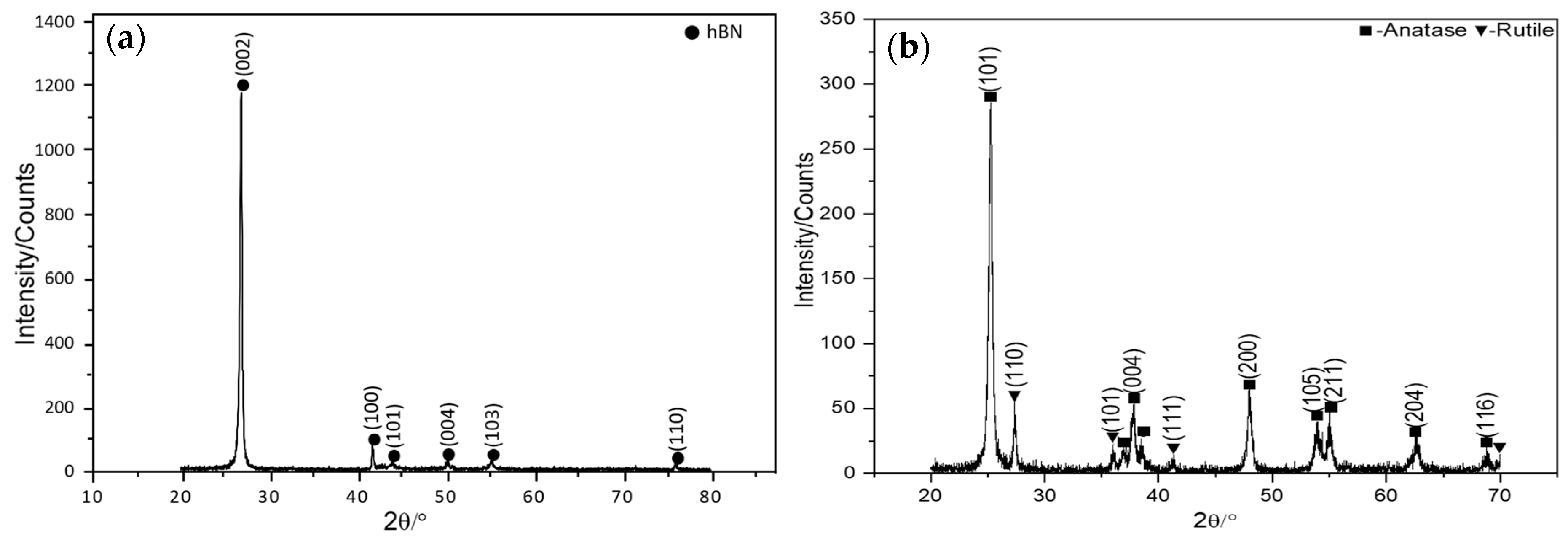
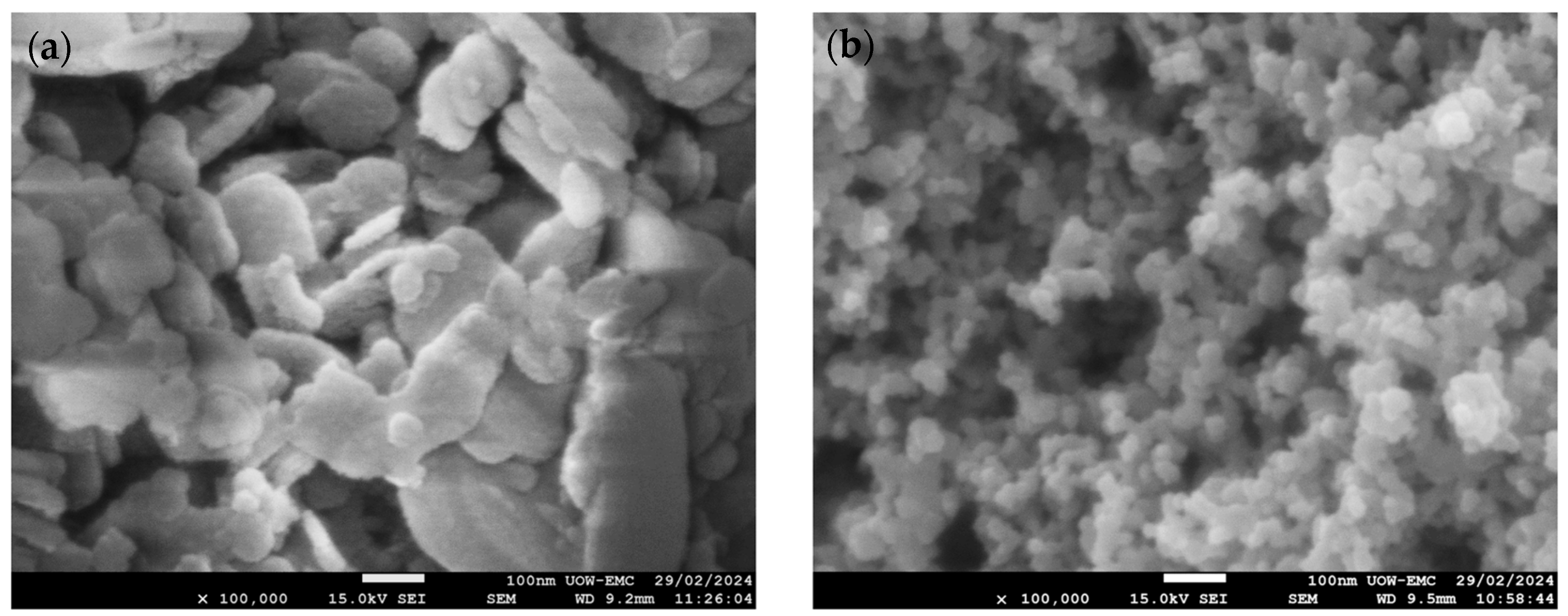
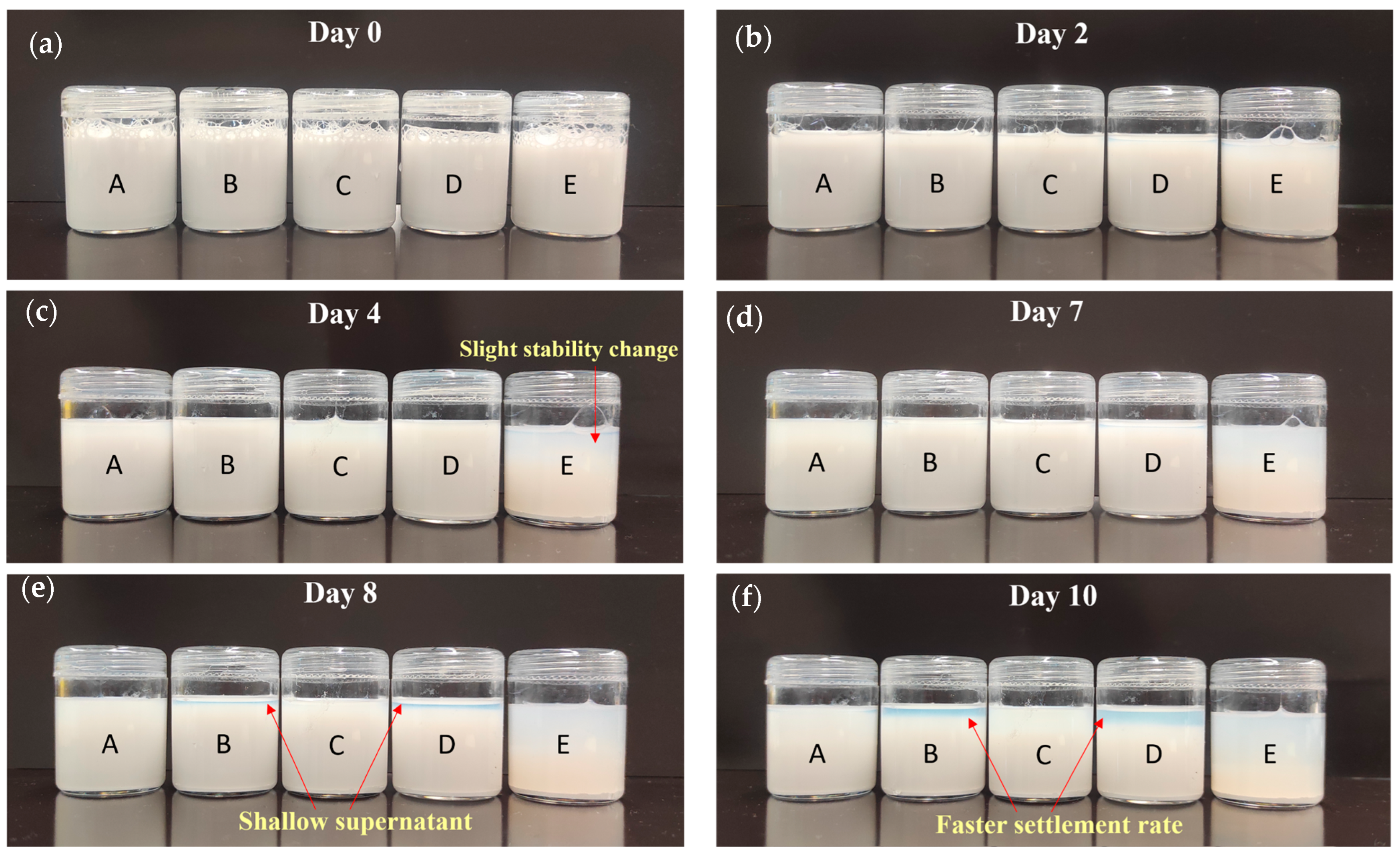
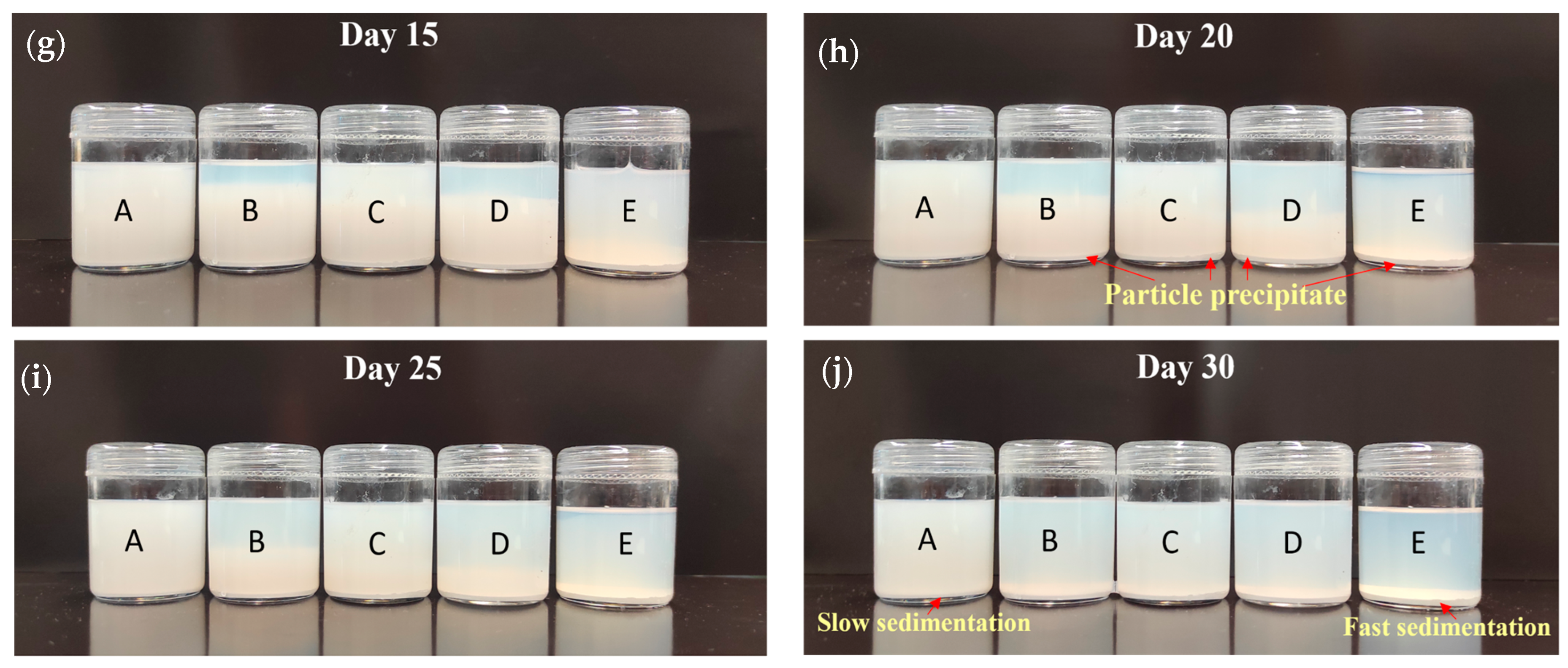




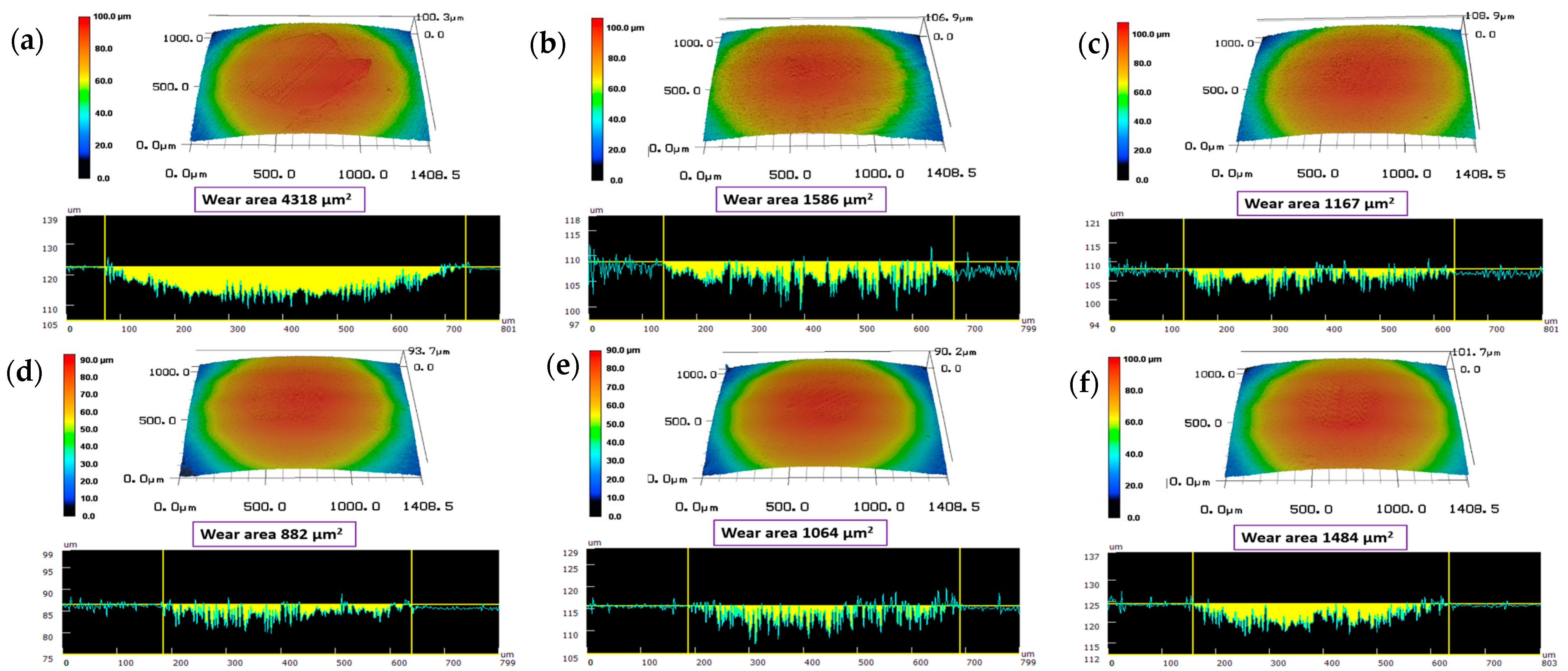


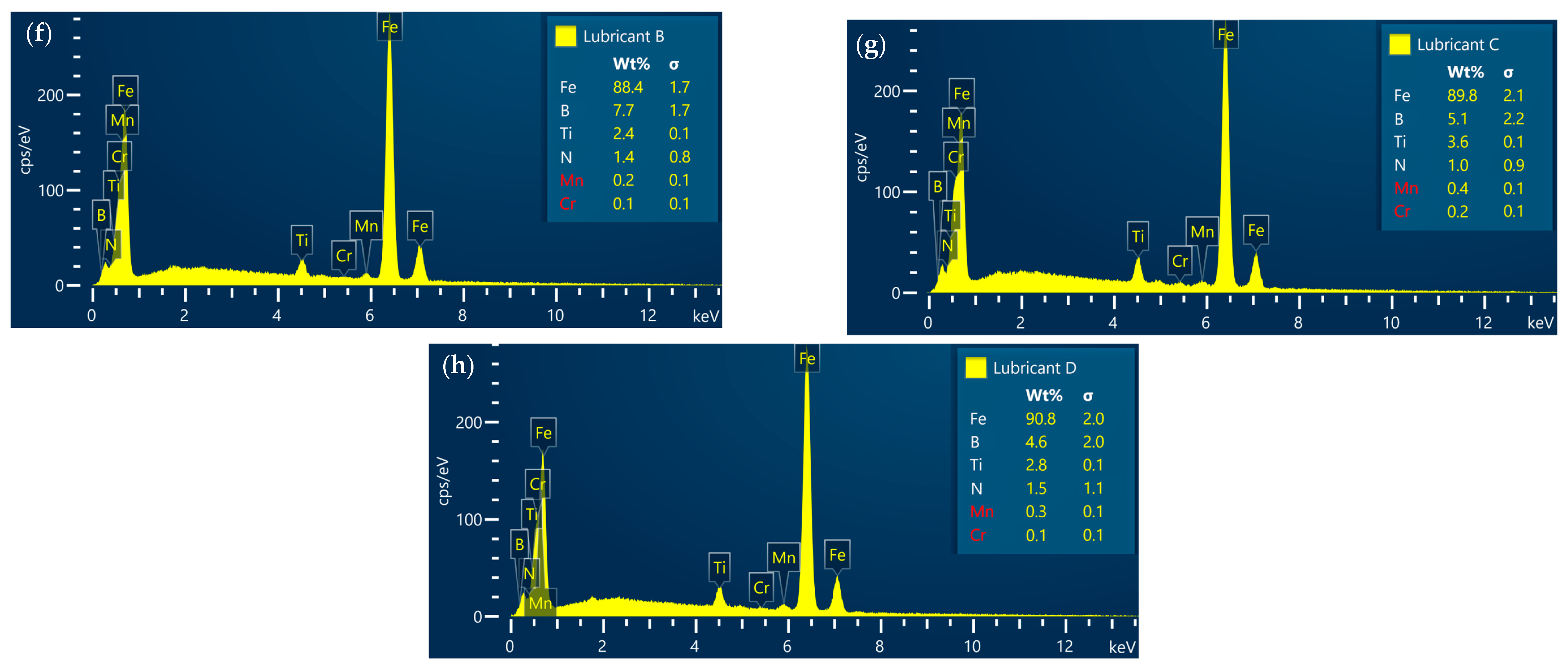

| Lubrication Type | Description |
|---|---|
| W | Distilled water |
| A | 1.0 wt% hBN + 0 wt% TiO2 + 10.0 wt% Glycerol + 0.2 wt% SDBS |
| B | 0.7 wt% hBN + 0.3 wt% TiO2 + 10.0 wt% Glycerol + 0.2 wt% SDBS |
| C | 0.5 wt% hBN + 0.5 wt% TiO2 + 10.0 wt% Glycerol + 0.2 wt% SDBS |
| D | 0.3 wt% hBN + 0.7 wt% TiO2 + 10.0 wt% Glycerol + 0.2 wt% SDBS |
| E | 0 wt% hBN + 1.0 wt% TiO2 + 10.0 wt% Glycerol + 0.2 wt% SDBS |
| C | Si | Mn | Mo | Ni | Cr | Nb + V + Ti |
|---|---|---|---|---|---|---|
| 0.16 | 0.25 | 1.5 | 0.007 | 0.006 | 0.02 | <0.02 |
Disclaimer/Publisher’s Note: The statements, opinions and data contained in all publications are solely those of the individual author(s) and contributor(s) and not of MDPI and/or the editor(s). MDPI and/or the editor(s) disclaim responsibility for any injury to people or property resulting from any ideas, methods, instructions or products referred to in the content. |
© 2024 by the authors. Licensee MDPI, Basel, Switzerland. This article is an open access article distributed under the terms and conditions of the Creative Commons Attribution (CC BY) license (https://creativecommons.org/licenses/by/4.0/).
Share and Cite
Morshed, A.; Wu, H.; Ren, M.; Xing, Z.; Jiao, S.; Jiang, Z. A Study of Water-Based Nanolubricants Using Hexagonal Boron Nitride (hBN)-Based Nanocomposites as Lubricant Additives. Lubricants 2024, 12, 123. https://doi.org/10.3390/lubricants12040123
Morshed A, Wu H, Ren M, Xing Z, Jiao S, Jiang Z. A Study of Water-Based Nanolubricants Using Hexagonal Boron Nitride (hBN)-Based Nanocomposites as Lubricant Additives. Lubricants. 2024; 12(4):123. https://doi.org/10.3390/lubricants12040123
Chicago/Turabian StyleMorshed, Afshana, Hui Wu, Mengyuan Ren, Zhao Xing, Sihai Jiao, and Zhengyi Jiang. 2024. "A Study of Water-Based Nanolubricants Using Hexagonal Boron Nitride (hBN)-Based Nanocomposites as Lubricant Additives" Lubricants 12, no. 4: 123. https://doi.org/10.3390/lubricants12040123






